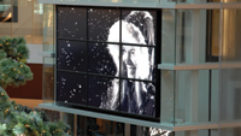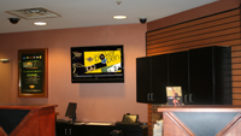
Digital Signage Templates: Feeding the Beast
Feb 12, 2010 4:44 PM,
By Keith Kelsen
Regardless of the type of network or the frequency of content refresh, keeping the content machine churning is a potentially daunting task. When the network is switched on, content needs to be produced and delivered in a constant stream. This is a problem familiar to people who put out content for many of the other four screens, such as the manager of a television station or the webmaster of an Internet news site. One of their main tasks every day is finding new content or determining what they have in their content library that can be re-presented to viewers.
Keeping ahead of content demands begins with the development of a significant pool of assets prior to launching the network. Think of these as basic building blocks that will be available for a relatively long period and can be mixed and matched in different ways. This is not stockpiling the content around a specific campaign, but rather it is about the overall look, feel, and identity of the site.
One key to keeping the content presentation fresh on some type of networks is to create a series of templates that can easily be adapted for most situations based on the objectives and messaging desired. Templates, simply put, are predesigned arrangements of graphic elements, colors, and empty space for specific content to be added. Rather than taking on the task of designing a new layout for each content segment, network managers save time and more easily retain the network’s identity by using templates. It’s not necessary to overdesign templates or make numerous complex changes for them to be effective. Think about designs where a simple change of color or one graphic element could take a template suitable for one use and turn it into another. For example, a template meant for financial news might have a green dollar sign in the upper left corner, a space for a headline, space for text below, and a block of space at lower right for a chart, all bordered in green. Change the dollar sign to a yellow sun, the chart to a thermometer, and the border to blue, and the template now can serve to show the weather report.
When considering templates, don’t be tempted to merely copy from one DOOH network to another. Every network has different needs, and the assets available and the type of templates created will be unique. If we are talking about a point-of-sale network—specifically an in-store network—the content will always have overarching brand messaging that appears along with product offerings. One can create brand elements and templates that will be used throughout the year to drive that brand messaging while leaving central locations for a product offering to appear. One can also create a layer within the brand messages for product offerings that will have their own brand. Creating elements to drive these offers is just one example of a template that can be reused and changed slightly to keep the messaging fresh. Menu boards are another great example of how templates can be used to change the pricing, pictures, or specials that need to be updated from breakfast to lunch and dinner.
For any network, one needs to create a set of templates that are refreshed at least once a quarter. This isn’t an exercise in rebranding the company or building an entirely new visual language for the network, but one should create variance that introduces new elements into the ones that have already enjoyed a three-month run. For example, create a series of templates that have corporate branding elements for a specific purpose. You may have a series of compliance messages that you need to get out, so create a template that is designed for that type of message. The viewer will learn that when that particular template is up, the content pertains to workplace compliance. Creating templates with branding elements for other types of messages will also play well with viewers. If you use the same template for everything, the viewer will get tired of the same look all the time.
It is also important that the templates create an overall look for the entire network—something that gives graphic consistency across screens. This is where we can take a lesson from TV. TV stations create that kind of identity so that even catching a brief glimpse of local programming or a promo spot will visually tell viewers they are watching Channel 5. Network owned and operated stations take that a step further; one can tell they are part of a particular network by the consistent visual cues like typestyle, screen layout, and even the shape of the station’s logo. Not only do digital signage networks benefit from this kind of continuity, the fact is that after many years of TV exposure, the viewer expects, even subconsciously, that certain standards of appearance and identity will be met.
Data content used in combination with Flash is also a great way to keep content fresh. One must be judicious with this type of solution and not overwhelm the viewer and keep the content relevant. A number of services will provide data-driven content that will help keep the content fresh. They include RSS feeds for sports, weather, stocks, flight information, news headlines, and traffic, to name a few. Even the TV and cable networks will provide RSS feeds to digital signage networks. These are feeds for which at least permission, and more likely a contract and fees, is required because the data are to be used in a commercial application.
One can also drive content with these RSS feeds. If a particular sports team wins, the product-related content can change in automated ways to present the relevant products based on the winning team. This can also be applied to products that are weather sensitive—for example, promoting umbrellas when it is raining.
Feeding the beast—keeping fresh and relevant content flowing to a digital signage network—is a big challenge, but we’ve seen that there is a wide variety of types and sources of content. Although not all of them are appropriate for a given network, the proper mixing and matching of content types will create and maintain interest among a network’s viewers. Content types serve to inform, entertain, or simply attract attention, and they serve to support the main messages of a screen and fill in the gaps around the core messaging. Organizing it correctly will also ensure that this content mixture amplifies the value of the network and doesn’t become clutter or noise that distracts rather than informs or motivates a viewer. Remember, keeping ahead of the game of content is a challenge that every network operator must overcome.
Keith Kelsen is chairman and CEO 5thScreen, founder of MediaTile, and the author of the book Unleashing the Power of Digital Signage-Content Strategies for the 5th Screen, from which this article is excerpted. ©2010 Keith Kelsen all rights reserved.










